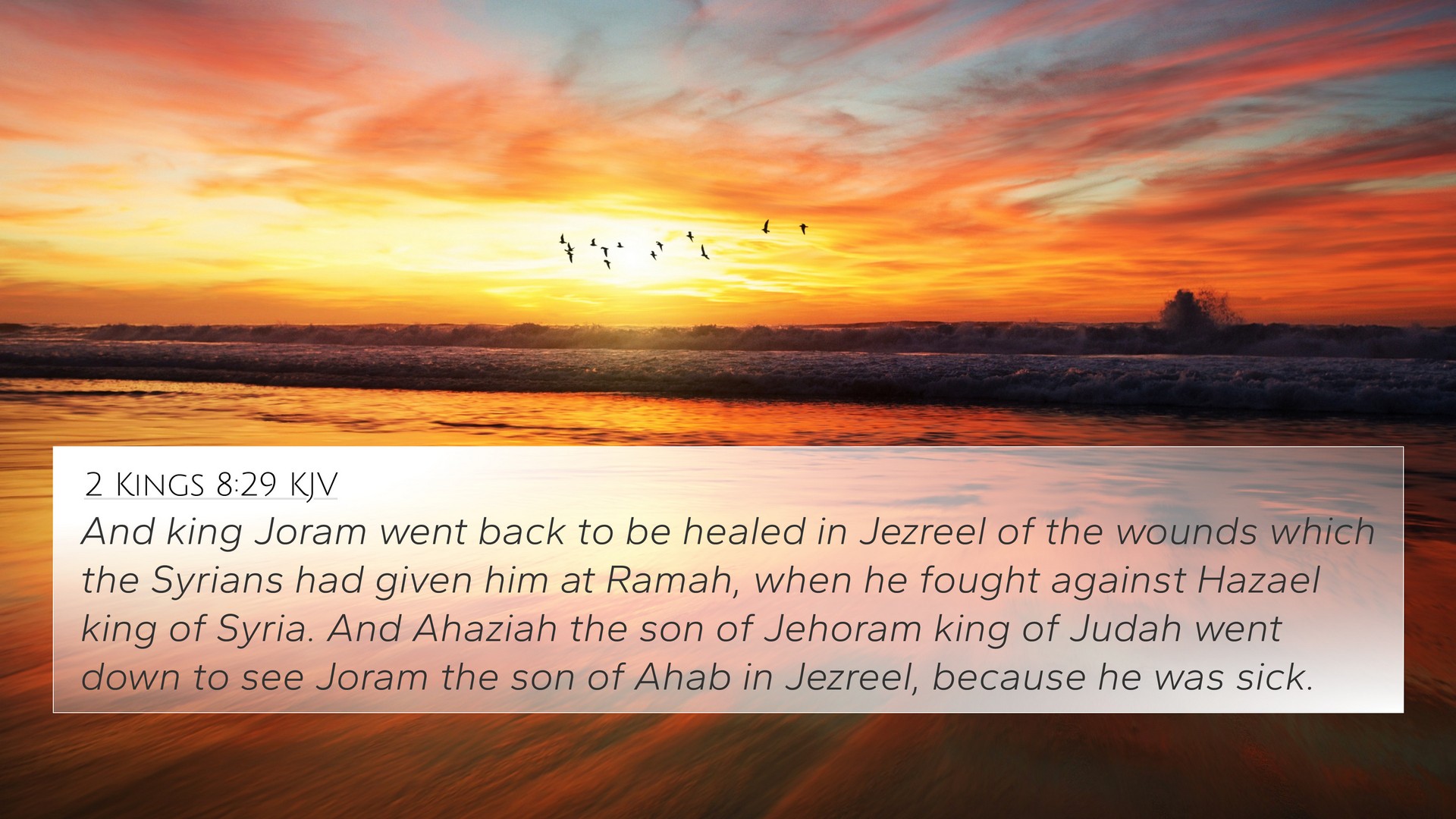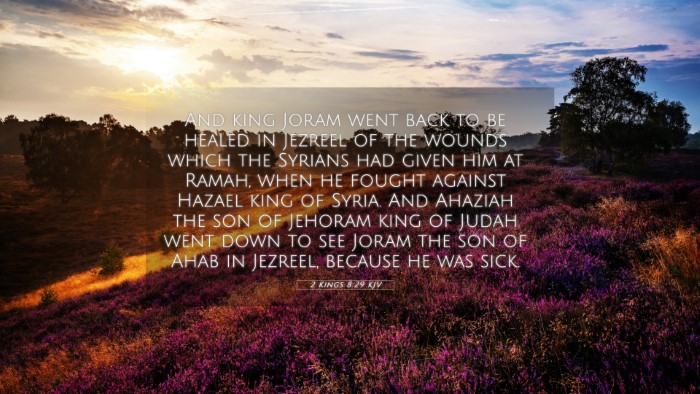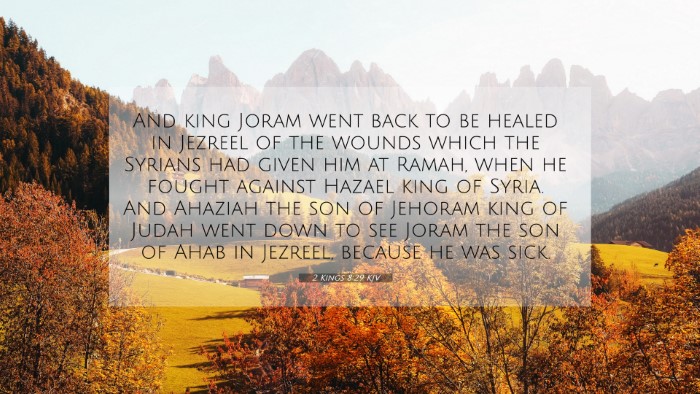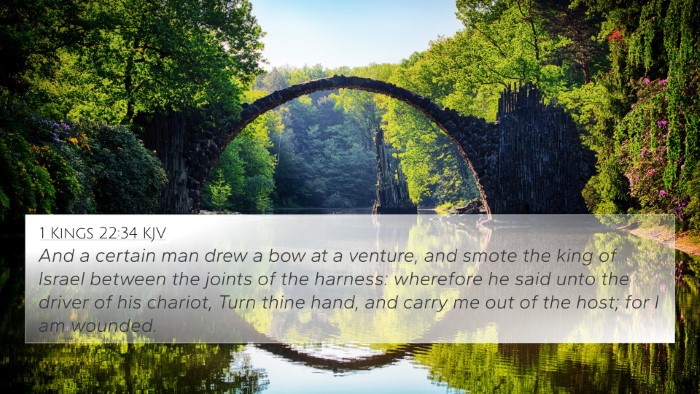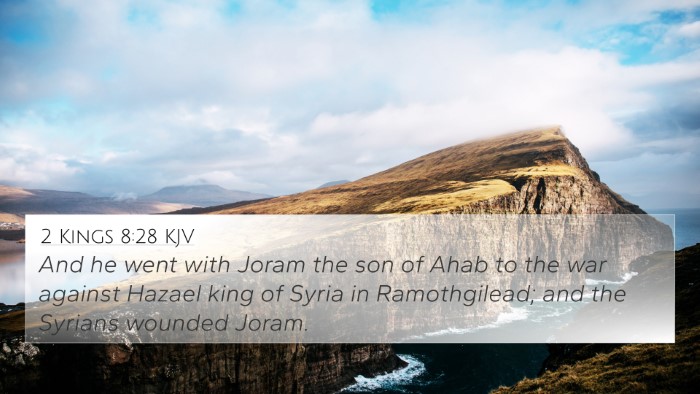Understanding 2 Kings 8:29
2 Kings 8:29 provides a pivotal moment in the history of Israel, focusing on King Joram of Israel and the implications of his actions. This verse serves as a narrative bridge that emphasizes the intertwined fates of the kingdoms of Israel and Judah.
Verse Context
This verse states: "And King Joram went back to be healed in Jezreel of the wounds which the Syrians had given him at Ramah, when he fought against Hazael king of Syria: and Ahaziah the son of Jehoram king of Judah went down to see Jehoram the son of Ahab in Jezreel, because he was sick."
Commentary Insights
Matthew Henry's Commentary:
Henry emphasizes the tragic yet instructive lesson from the unfortunate circumstances surrounding King Joram. His desire for healing, driven by his previous engagements in battle, is indicative of the broader conflicts of his reign. The alliance reflected by Ahaziah visiting Joram symbolizes the continuing lineage of problematic leadership within Israel and Judah, sustaining the theme of political instability.
Albert Barnes' Notes:
Barnes interprets the visit of Ahaziah as significant, showcasing the familial ties and alliances that often dictated political movements. He notes that Joram's injuries were a direct consequence of his conflicts with Hazael, which underscores the tumultuous relationships between Israel and its neighbors. The visit also reflects the bond of kinship amidst political strife, a recurring theme in the history of the kings of Israel and Judah.
Adam Clarke's Commentary:
Clarke suggests that the wounds sustained by Joram symbolize divine judgment, aligning with the broader scriptural theme that disobedience to God leads to suffering. The subsequent visit from Ahaziah appears to be more than merely a gesture of goodwill; it signifies potential political maneuvering and could denote an impending alliance or conflict in the troubled political landscape of the region.
Bible Verse Cross-References
- 1 Kings 22:32-35 - Insights into the conflicts of the northern kingdom and the role of the prophets.
- 2 Kings 5:1 - The story of Naaman demonstrates the effects of Syrian military actions on Israel.
- 2 Kings 9:14 - Elisha’s instruction to anoint Jehu as king connects to the historical fluidity of power.
- 2 Chronicles 21:18-20 - Provides additional detail about Joram’s reign and judgment.
- Isaiah 7:1-2 - The geopolitical context of the time, highlighting the impact of wars on the nations.
- Hosea 1:4 - Discusses God’s judgment upon the house of Jehu, linking to Joram's lineage.
- Matthew 1:12 - References the heritage leading to Jesus, showcasing the continuation of God’s plan despite human missteps.
Thematic Connections
The thematic exploration of 2 Kings 8:29 reflects the frailty of human power and the consequences of our choices. In particular, the connections between the action of visiting an ailing king and the wider narrative of opposition and support encapsulates much of the socio-political dynamics at play during this period in Israel’s history. The inter-biblical dialogue concerning kingship, divine judgment, and human frailty is profound.
Key Lessons
- The inevitability of consequence from our actions.
- The continual need for divine guidance in leadership.
- The role of familial ties, which can lead to alliances or conflict.
- The importance of reading subsequent biblical narratives to grasp the full impact of this verse.
Cross-Referencing for Deeper Study
Utilize tools for Bible cross-referencing to deepen the understanding of the narratives and themes within the biblical text. Consider the following:
- Bible concordance for identifying key phrases and themes.
- Bible cross-reference guides to track familial and political connections.
- Cross-reference Bible study methods that focus on thematic elements.
Conclusion
2 Kings 8:29 invites readers to reflect on the complexities of biblical history, the damage wrought by sin and conflict, and the intricate ties that bind the leaders of Israel and Judah. Understanding this verse through comparative Bible verse analysis not only enhances comprehension but also enriches one's faith through contextual appreciation.
Ultimately, this verse exemplifies the importance of linking Bible scriptures, allowing for a more comprehensive grasp of the overarching narratives present throughout Scripture, encouraging deeper engagement with the Word.
